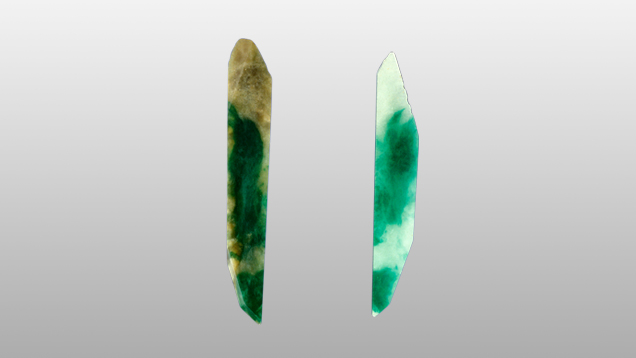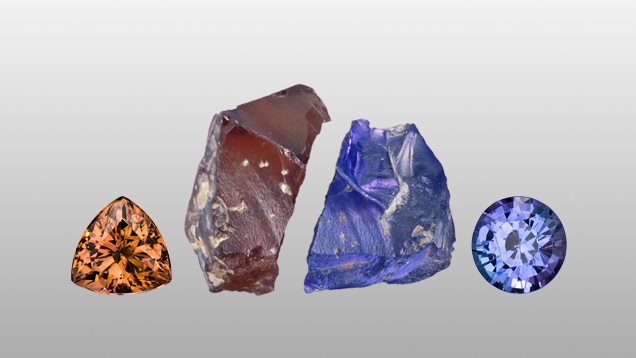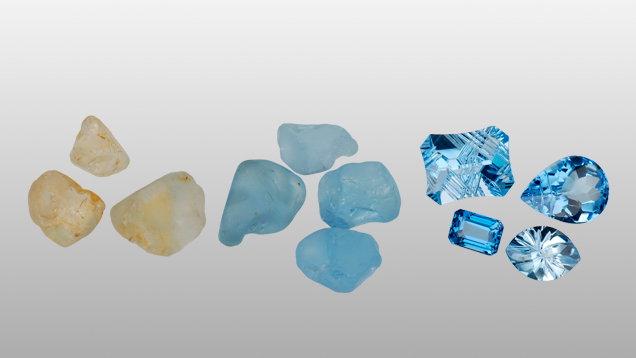Treatments
Many gems on the market have been treated by various methods to improve or alter their appearance.
Different treatments can be used to darken or lighten the colour of a gem, create an optical phenomenon like a star effect, or to improve a gem’s clarity. Treatments can also be used to improve a gemstone’s durability by making it more resistant so it will maintain its beauty over time. Sometimes multiple treatments are used to obtain the desired effect.
Whether or not a gem has been treated can have a significant effect on its value, which is why it is important to disclose any and all treatments when gems are sold. As a member of the International Colored Stone Association (ICA), Pierres de Charme adheres to a strict code of conduct and will always disclose known treatments. [1] ICA members mention all gemstone treatments with standardized codes indicated on their invoices. American Gem Trade Association (AGTA) and World Jewellery Confederation (CIBJO) members follow the same rules and use the same codes. [2]
The following section offers details about the most common gemstone treatments.
Types of Treatments
Bleaching
Bleaching agents are used to lighten, eliminate, or homogenize a gem’s colour. This is a relatively stable treatment as long as the gem is not re-cut or polished following the procedure. This treatment may have a negative impact on the gem’s durability, which is why it is often combined with an impregnation treatment (see: Impregnation later in this section). This treatment can be very difficult to detect even with magnification.
- Although natural golden coral exists, black coral is often bleached to give it a golden colour.
- Jadeite jade can also be bleached to make dark colours lighter or more uniform. Jadeite is often impregnated with a resin after bleaching. This material is referred to as B-Jade.
- Many cultured pearls are bleached to give them a uniform white colour and some Tahitian pearls are bleached to give them a brown or “chocolate” colour.
- Some quartz varieties including chalcedony and tiger’s eye can be bleached to lighten their colour.
Dyeing
Dyeing can be used on all porous or permeable gemstones. Dye is used to add, alter, or homogenize a gem’s colour. Gemmologists use a jeweller’s loupe or a microscope to observe telltale colour concentrations that indicate treatment. They can also use a spectroscope to detect the presence of dyes especially those with chromium and ultraviolet fluorescence may give indications of dye treatments.
Dye treatments are, in general, not very stable treatments. Over time, the colours may fade or discolour. It is very important to disclose the presence of dye as it often has an influence on the value and may require special care.
- Precious coral and sponge coral are often dyed pink or red.
- Pale or previously bleached jadeite can be dyed many different colours but is often given bright green or lavender colours. Jadeite that has simply been dyed is referred to as C-Jade and if it has been bleached, impregnated and dyed it is referred to as B & C Jade.
- Lapis lazuli can be dyed to improve the colour. Many lapis imitations like jasper, howlite, and magnesite are dyed dark blue to resemble lapis.
- Inferior quality pearls can be dyed in a vast array of colours. Some pearls are dyed grey and black using a silver nitrate solution in order to imitate Tahitian cultured pearls.
- Polycrystalline quartz is very porous and is often dyed in an array of colours.
- Turquoise can also be dyed to improve the intensity or uniformity of its colour. Howlite and magnesite are two gem materials that are often dyed to imitate turquoise.
Emeralds, some corundum, and opals can also be treated with dyes.
Surface Coating
Coating treatments consist of applying a thin layer of different materials to the surface of the gem. Most coatings are applied to the pavilion but can also be applied to the entire surface of the gem. Coatings can produce all imaginable colours and sometimes many at the same time as in the case of “Mystic Topaz” that displays a rainbow-like iridescence.
Coatings are generally easily detected with a loupe but they can be hidden by some gem settings. Gemmologists look for surface features and scratches in the material. Depending on the material used, this treatment has a variable stability. Coatings can be damaged by contact with metals or other gems and should be treated with care.
- Dark coloured coatings can be applied to the base of amber cabochons in order to produce a greenish colour.
- Diamonds with a slight hint of yellow can be treated with a blue coating to mask the presence of yellow and make the stone appear more colourless.
- Colourless topaz and rock crystal are the two gems that are most often treated with coatings. Coatings on these gems can produce the entire spectrum of colours. Thin layers of chemical elements such as titanium or cobalt can produce iridescent colours. Cubic zirconia can also be coated to produce coloured gems.
Less often, pearls, tanzanite, tourmaline and turquoise can also be treated this way on the market.

Impregnation and Fracture Filling
Impregnation and fracture filling treatments are designed to improve a gemstone’s clarity and/or durability. Gems with surface reaching fractures, cavities, or porous surfaces can be treated by impregnation or infilling. These treatments are generally easily detected with a loupe or microscope.
Impregnation
Impregnation treatments can be done with simple materials such as wax used to fill small surface cavities to improve the gem’s lustre and surface quality. Synthetic resins can also be used to improve the durability of fragile gems or gems that have been weakened as a result of other treatments such as bleaching.
The stability of impregnation depends largely on the material used. Wax treatments can wear away after a few years however they can be reapplied very easily. Resin treatments are generally more stable. Impregnation is a common and accepted treatment routinely performed on a number of gems such as turquoise, jade, lapis, ammolite, and others. Impregnation treatments can sometimes be difficult to detect.
- Soft corals like sponge coral are often impregnated with resin to improve their durability[4].
- Jadeite that has not been bleached and is simply treated with wax or paraffin to improve lustre is called A-Jade. Jadeite that has been bleached is often subsequently impregnated with resin to improve durability.
- Turquoise is a very porous material with poor durability and it is routinely impregnated with wax or resin to improve appearance and durability.
Fracture Filling
Gems with surface reaching fractures can be treated by introducing different materials into the fractures to improve the gem’s clarity or transparence. Oils, resins, borax, or lead glass can be used to make fractures less visible. Specific filler substances are chosen for treating different gems based on their refractive indices. Filler materials may also be coloured to improve or add colour to the gem.
Most fracture filling treatments are stable but gems treated in this manner often require special care so disclosure is imperative. Gemmologists can easily detect these treatments using magnification.
- Most emeralds on the market have been fracture filled with oil to make their internal fissures less visible. There are many different types of oils and resins used for treating emeralds.
- Opals naturally contain water and if they dry out they can crack or fracture. Resins can be used as a sealant to help protect opals from damage. Oils can be used to mask small surface cracks on opals that already show crazing.
- A large number of commercial quality rubies have been fracture filled with lead glass or other filler substances. This treatment improves the transparency and clarity of low quality gems. This treatment is not stable and Pierres de Charme does not sell these stones.
- Many tourmalines have surface reaching fractures and they can be treated with oils or resins to improve their appearance.
All gems that have surface reaching fractures can potentially be treated with oils or resins to improve their clarity.
Heating
Heat treatment is one of the oldest known gem treatment techniques and can be used to alter and enhance a gem’s appearance in many different ways. Heat treatments can lighten, darken, or change the colour of gems. Heat treatments can also be used to improve the clarity of some gems by melting or altering certain types of inclusions. Heat may also be used to induce inclusions that create star effects. Some gems are heated then rapidly cooled to create fractures (quench crackling) that can then be used to dye the gem and alter its colour.
Most heat treatments are stable and treated gems do not require special care. These treatments can be difficult to detect and may require laboratory testing.
- Most corundum on the market today has been heat treated to enhance its appearance. These treatments can produce a vast array of results depending on the temperatures used and the heating environment (with or without oxygen). Heat can improve clarity by reducing the visibility of rutile needle inclusions or create them in order to give a star effect. Heat is most often used to alter the colour of corundum by affecting the chemical elements responsible for colour such as iron, titanium and chromium. Rubies with brown or blue nuances become more vibrant reds, colourless sapphires can be changed to blue, and dark or light sapphires can be altered to more desirable colours. Fancy coloured sapphires, particularly yellow sapphires, are also heated to improve their colour.
Heat-treated corundum is stable and considered acceptable by the industry. Good quality untreated corundum is rare and commands a premium in the market. Untreated stones usually have reports from advanced laboratories.
- Greenish aquamarines are heated to remove nuances of yellow making them a more pure blue. This treatment is both stable and quite common.
- Amber is often clarified using heat to eliminate small bubbles improving the clarity and transparence. It is important to cool the amber slowly after the treatment or else reflective, disc-like inclusions called ‘sun spangles’ will be produced. Amber can also be treated by ‘burning’ it to darken the colour and make it look older.
- Yellow jadeite is heated to give it a brownish overtone and an aged appearance.
- The yellow colour of citrine is a result of heating amethyst. Rock crystal quartz can also be heated and then rapidly cooled to induce fractures (quench crackling) which are then filled with a coloured solution to add colour. This treatment is easily detected with magnification.
- Tourmaline is heated to enhance its colour. Dark green stones are heated to lighten the colour and pink or purple copper bearing tourmalines can be heated to get an electric blue colour. These treatments are stable.
- Heat is the second stage of a common topaz treatment used to get different shades of blue. The first stage of the treatment is irradiation (see later in this section).
Many other gems such as nephrite, tanzanite, spodumene, zircon, and fluorite can also be heated to improve their appearance.
Diffusion
Diffusion treatments are used to modify colour or create star effects. It is primarily done on corundum: sapphires, rubies and padparadsha sapphires.
The gem is heated at high temperatures in the presence of chemical elements for an extended period of time. Different chemical elements will produce different colours or effects: titanium is used to create a star effect or blue colour and chromium is used to produce red [4]. Gems must be facetted before the treatment because these elements only penetrate a fraction of a millemetre below the surface. The treatment will be removed if the stone is re-cut. Trained gemmologists will use careful observation to detect this treatment.
Lattice diffusion is another treatment that uses the element beryllium. As beryllium is a much smaller element it can penetrate the entire stone. This treatment is more permanent than surface diffusion and can produce a wide range of colours. Lattice diffusion can be difficult to detect.
Irradiation
Exposure to different types of radiation such as certain isotopes or neutron and electron bombardment can be used to alter the colour of gemstones. These processes can have effects that closely resemble natural radiation and can therefore be difficult to detect. Modern irradiation treatments are safe and stones treated in this way do not pose a danger.
Irradiation treatment is sometimes followed by heat treatment to produce the desired effect. For some gems like corundum and spodumene (kunzite) the results are not stable. However most irradiation treatments performed on topaz, quartz, beryls, diamonds, and pearls are considered stable.
- Blue aquamarines can be irradiated to add nuances of green (these may have been eliminated by heat treatment), and aquamarine or colourless beryl can be irradiated to produce yellow[5]. Most morganites have been irradiated to intensify the pink colour by removing yellow overtones.
- Many quartz varieties are irradiated to produce marketable colours. Colourless, rock crystal, quartz is irradiated to produce greenish yellow or brown (smoky) colours. Citrines can be irradiated to change their orange colour to various shades of purple (amethyst). Most prasiolite (also sometimes called green amethysts) owe their colour to irradiation.
- Natural blue topaz is rare and usually very pale so almost all blue topaz found on the market has been treated with irradiation and heat. Colourless topaz is irradiated to produce brown and then it is heated to produce a variety of different shades of blue including London Blue, Swiss Blue, and Sky-blue. This treatment is stable and accepted in the industry.
- In saltwater cultured pearls irradiation turns the bead nucleus black making the pearls appear grey, blue, or black. Careful observation down the drill hole allows gemmologists to detect this treatment.
Other gems including diamonds, chrysoberyl, spodumene, tourmaline, and zircon can also be irradiated to improve or alter their colour.
1. H. It is the duty of every ICA member to protect the industry and their clients against fraud, misrepresentation, and unethical practices in gemstone transactions and avoid exaggeration and concealment of any pertinent facts. Each member should endeavor to eliminate any practices which could be damaging to the industry or bring discredit to the trade. Code of Ethics. (n.d.). Retrieved June 3, 2017, from http://www.gemstone.org/mission/code-of-ethics
[2]In recognition of the ever increasing importance of proper disclosure of gemstone treatments three major global organizations, the American Gem Trade Association (AGTA), the World Jewellery Confederation (CIBJO), and the International Colored Stone Association (ICA), have reached consensus on a global method of colored gemstone treatment disclosure within the trade. AGTA, CIBJO and ICA Join to Adopt Colored Gemstone Disclosure Codes. (n.d.). Retrieved June 6, 2017, from http://www.cibjo.org/pressreleases/release_4310.pdf
[3] (2010). Co-3. In Cours de base en gemmologie Gem-A. London.
[4] Section 13-7. In Cours de base en gemmologie Gem-A. London,
[5] Section D13-16. In Cours de base en gemmologie Gem-A. London,







